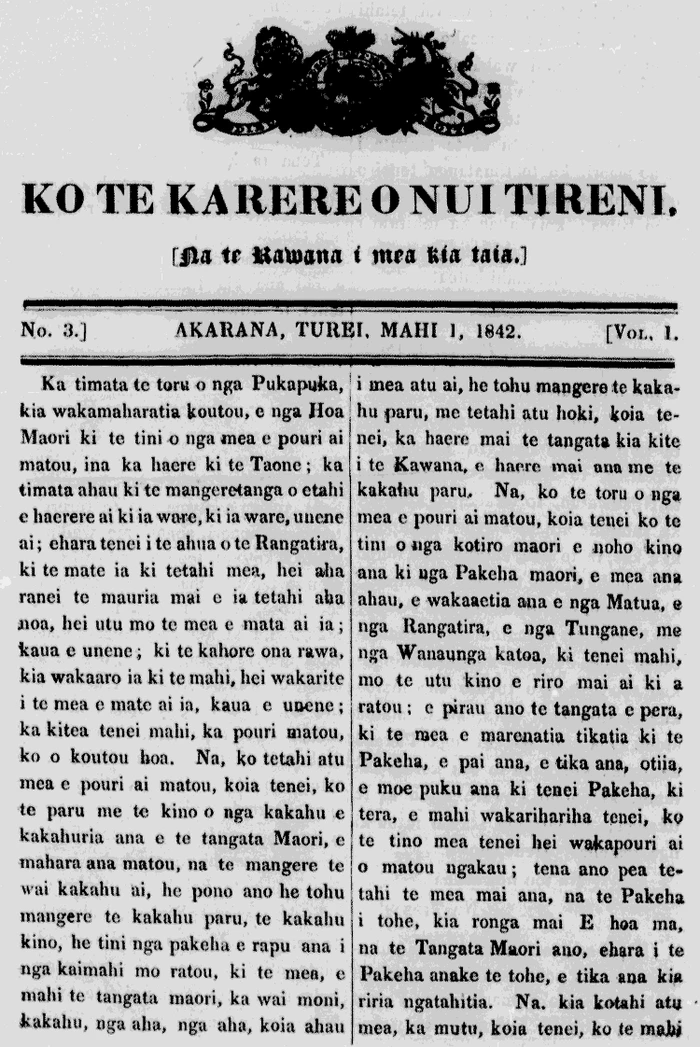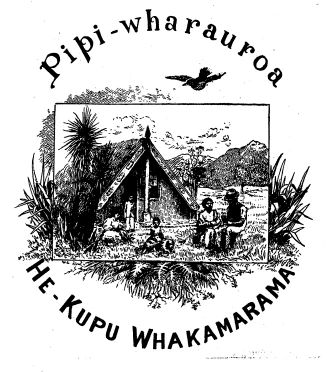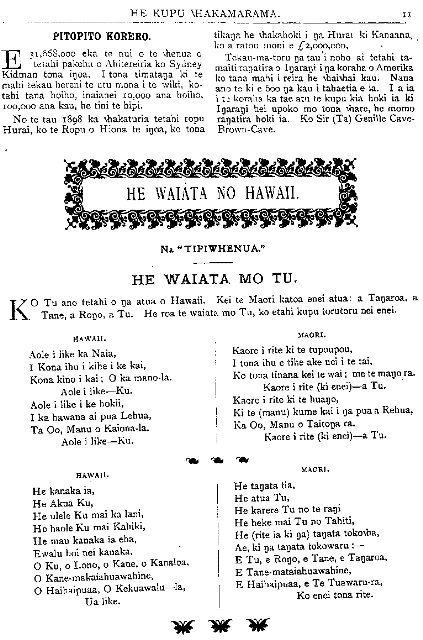He Manu Karere - The Early Māori Newspapers
What do you get when you cross Gutenberg’s printing press with the communal, oral storytelling of Māori tradition?

When New Zealand’s first printing press arrived at Waitangi in the 1830s, the answer soon became clear: you got a print revolution.
The first book produced in New Zealand followed soon after this, an edition of Biblical epistles produced by CMS missionaries in the Bay of Islands. Many publications of various kinds followed, and by 1842 the first newspaper (niupepa) in Māori, Ko Te Karere o Nui Tireni, produced by the government, was already in production. Estimates of Māori literacy in the middle of the 1800s varied, but it is fairly certain that in many areas, rates of those able to read and write in their own language were at least as good as of the English population. The Niupepa found a ready-made readership and, and plenty of demand for news of events and other articles.

The masthead of Ko Te Karere o Nui Tirene.
Te Karere was quickly followed by around 34 more Māori newspaper publications in Te Reo, many publishing at the same time in the 1850s. Around 70% of content was published in Te Reo Māori only, 27% bilingually, and 3% in English only. Some papers were published by government, particularly through what was then the Department of Native Affairs, some by churches, particularly Anglicans and Wesleyans, and some by Māori movements including the Kingitanga and Kotahitanga. The different sponsors of the newspapers greatly influenced the content they published, which could range from collections of pēpeha, Māori proverbs, to government exhortations for allegiance to the crown. Inevitably, worsening frictions between iwi and settler government were reflected in the newspapers, and some operated in direct opposition.
The most notable government paper Te Pihoihoi Mokemoke and its Kingitanga counterpart, Te Hokioi, both of which sought to win the minds of people nationwide to their position at the height of the Waikato War. The competition escalated to the point where a group of Kingitanga warriors went to the press of Te Pihoihoi in Te Awamutu, took the entire printing press, and removed it from its printing works, effectively putting a stop to the war of words.
Many niupepa were highly nuanced, and drew on traditional metaphor to communicate their purposes. The imagery of a newspaper as a bird, bringing information to readers just as migratory birds brought their first birdsongs to signify summer and renewal, was very popular. Many niupepa expanded the metaphor, drawing parallels between subscriptions and “food for the bird”, sad news of accidents and deaths as mournful birdsong, and wrote of “our bird” frequently. A bird can be seen in several intricate masthead images, as in the image from Te Pipiwharauroa - a shining cuckoo soaring down over a peaceful home and a family sitting reading.

The masthead of Te Pipiwharauroa.
As well as news from both Aotearoa and internationally, the niupepa often published stories, anecdotes of daily life, and translated English or foreign texts including poetry by Robert Brown and William Cowper, and excerpts from Shakespearean plays. Te Pipiwharauroa also published translations of, for example, Hawaiian songs, with Māori translation by the editors.

A song translated from Hawaiian to Māori, featured in a copy of Te Pipiwharauroa in 1924.
Māori newspapers peaked in number in the 1850s, and declined to just three by the beginning of 1900. None of the niupepa from this period are still in production, having been replaced from the 1970s with other forms of media. However, many have been preserved in libraries and archives, and are available to study today as a fascinating insight into Māori history and society during this time.
Wellington City Libraries holds microfiche reproductions of many niupepa, available for viewing on the second floor of Central Library. We also hold several books about Māori newspapers, printing, and literacy.
Further reading:
- Colonial discourses : niupepa Māori, 1855-1863 by Lachy Paterson.
"Paterson examines nine Maori-language newspapers in New Zealand over an eight-year span, starting with the revitalization of the government newspaper, Te Karere Maori, and ending with its demise. Examining the material, social, cultural, and political content, Paterson finds that the Maori-language newspapers were used for propaganda purposes and that those run by European settlers, while possessing different agenda, effectively spoke with one voice regarding religious, social and political issues. He also argues that the newspapers informed and influenced Maori readers but at the same time provided a platform for the Maori to voice their opinions and debate issues of the time with the European settlers..." (adapted from the Syndetics summary) - Rere atu, taku manu : discovering history, language and politics in the Māori language newspapers | Edited by Jenifer Curnow, Ngapare Hopa and Jane McRae.
"Collection of articles by scholars of Maori language who have researched Maori language newspapers from the 1840s into the twentieth century. The book uncovers Maori opinions on such matters as Maori representation in Parliament, the philanthropic and religious messages between Pakeha and Maori and Maori oratory and skilful use of the language." (Syndetics summary) - Book & print in New Zealand : a guide to print culture in Aotearoa | edited by Penny Griffith, Ross Harvey, Keith Maslen, with the assistance of Ross Somerville.
"A guide to print culture in Aotearoa, the impact of the book and other forms of print on New Zealand. This collection of essays by many contributors looks at the effect of print on Maori and their oral traditions, printing, publishing, bookselling, libraries, buying and collecting, readers and reading, awards, and the print culture of many other language groups in New Zealand." (Syndetics summary)